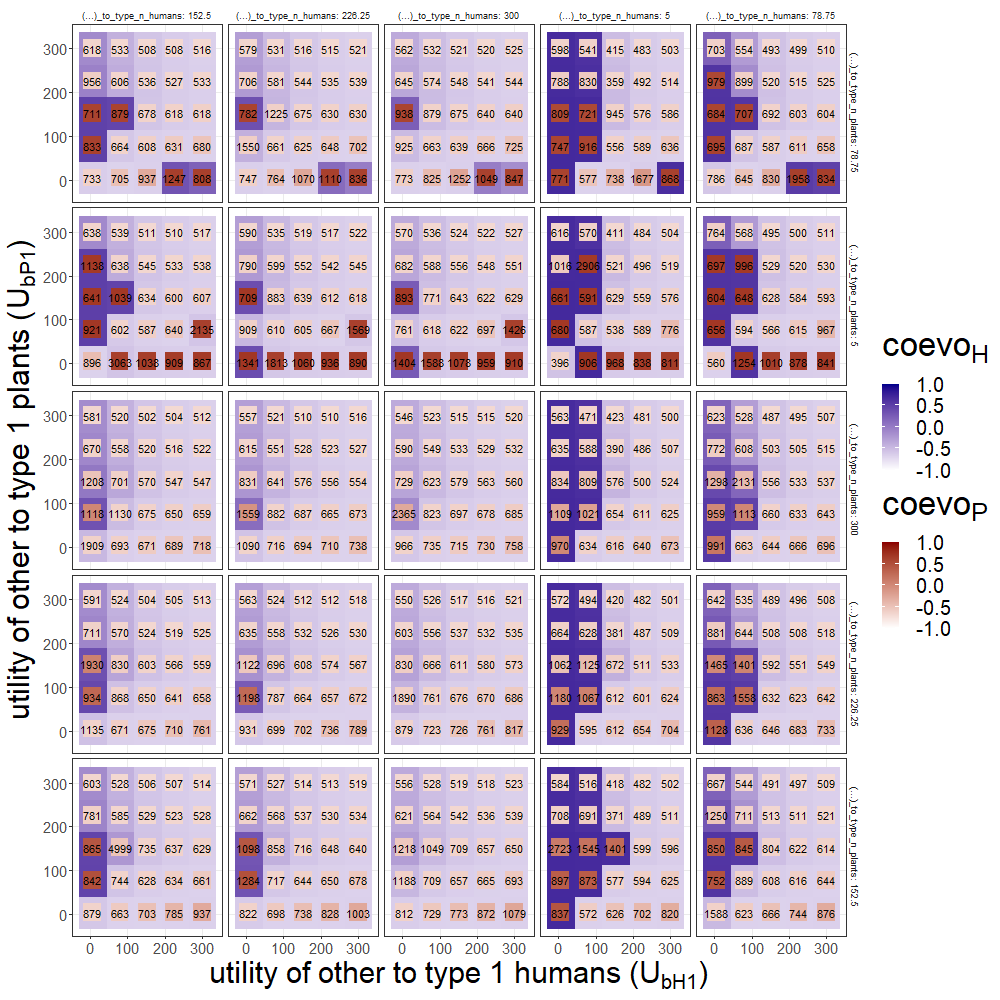4.3 Utility from other resources to humans and plants (\(U_{bH_{1}}\) x \(U_{bP_{1}}\) x \(U_{bH_{n}}\) x \(U_{bP_{n}}\))
For this experiment, consider that the default setting includes \(MaxArea=200\) (i.e. the maximum for the plant population).
| parameter | value |
|---|---|
| initial_population_humans | 10 |
| initial_population_plants | 10 |
| number_types_humans | 30 |
| number_types_plants | 30 |
| undirected_variation_humans | 0.15 |
| undirected_variation_plants | 0.15 |
| intrinsic_growth_rate_humans | 0.04 |
| intrinsic_growth_rate_plants | 0.1 |
| utility_per_capita_type_n_plants_to_humans | 1.5 |
| utility_per_capita_type_n_humans_to_plants | 1 |
| utility_per_capita_type_1_plants_to_humans | 0.15 |
| utility_per_capita_type_1_humans_to_plants | 0 |
| utility_other_to_type_n_humans | 5 - 300 (sample = 5 ) |
| utility_other_to_type_n_plants | 5 - 300 (sample = 5 ) |
| utility_other_to_type_1_humans | 5 - 300 (sample = 5 ) |
| utility_other_to_type_1_plants | 5 - 300 (sample = 5 ) |
| max_area | 200 |
| max_iterations | 5000 |
| reltol_exponential | 6 |
| coevolution_threshold | 0.5 |
| humans | 7.02756257875232 - 560.973786604167 (sample = 625 ) |
| plants | 6.24776319282656 - 200 (sample = 256 ) |
| coevolution_coefficient_humans | -0.662899373475303 - 0.703777349450851 (sample = 625 ) |
| coevolution_coefficient_plants | -0.682616984408088 - 0.704560157675581 (sample = 625 ) |
| dependency_coefficient_humans | -0.709161863456466 - 0.964351497555221 (sample = 625 ) |
| dependency_coefficient_plants | -0.793157825095748 - 0.969736541196175 (sample = 625 ) |
| timing_humans | 0 - 1593 (sample = 54 ) |
| timing_plants | 0 - 2475 (sample = 54 ) |
| time_end | 359 - 4999 (sample = 362 ) |
| adaptativeCost.H | 0 |
| adaptativeCost.P | 0 |

Interpretation:
- Lower values of the two human-related parameters (\(U_{bH_{1}}\), \(U_{bH_{n}}\)) facilitate coevolution; under the ‘default’ setting and for all four parameters, values greater or equal to \(MaxArea\) (here, 200) impede coevolution. Inversely, higher values of the plant-related parameters (\(U_{bP_{1}}\), \(U_{bP_{n}}\)) facilitate coevolution. The human-related parameters, together regulating the scale of the subsistence alternatives for humans, are significantly more important; their relationship (if one is greater than the other) seems to be less important as long as their combined sum is small enough.
- Coevolution is likely to occur when \(U_{bH_{1}}=5\) (first row in small grids), unless \(U_{bH_{n}}\) is too big and \(U_{bP_{1}}\) is too small.
- As a summary of possible end-states:
+ ‘Fast’ coevolution (red square in blue tile, small t): most cases when \(U_{bH_{1}}\) and \(U_{bH_{n}}<153\).
+ Domestication without cultivation (red square in whitish tile): most cases when \(U_{bP_{n}}=5\), \(U_{bP_{1}}=5\) (i.e. there is very little carrying capacity for plants beyond the anthropic space) and \(U_{bH_{1}}>5\) (i.e. humans get enough of other resources when -still- not engaged in agriculture).
+ Cultivation without domestication (whitish square in blue tile): no cases are visible under these conditions.